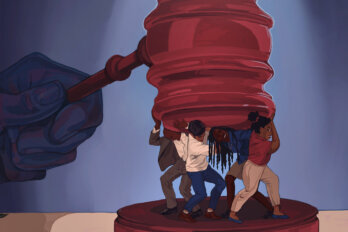Back in the late 1990s, Colin Sheppard, then a twenty-four-year-old unemployed carpenter from Spaniard’s Bay, Newfoundland, was accused of stealing two windows worth $429 from a local building supplies outlet. The only evidence against Sheppard was that of his former girlfriend, Sandra Noseworthy, who—two days after the relationship ended—told police that Sheppard had confessed the theft to her a month earlier.
The breakup was a bad one. Sheppard testified that Noseworthy had threatened him at the time, saying: “I hope you live your life in misery. If I have anything to do with it, you will.” When asked about it at trial, Noseworthy stated: “Maybe I did say it. Maybe I did.”
It was a credibility case. Noseworthy swore up and down that Sheppard had told her he’d taken the windows. Sheppard just as vigorously denied it. Either witness could have been lying—Sheppard to evade justice, Noseworthy to exact her revenge. It was up to the trial judge, Judge Barnable, to decide who was telling the truth.
Barnable convicted Sheppard. He probably preferred Noseworthy’s evidence, but we can’t know for sure, or why. The reasons for judgment don’t say. They are short enough that they can be reproduced here, in full:
Having considered all the testimony in this case, and reminding myself of the burden on the Crown and the credibility of witnesses, and how this is to be assessed, I find the defendant guilty as charged.
Barnable ordered Sheppard to pay a fine of $1,000, along with the cost of the windows. Instead, Sheppard appealed his conviction before three judges of the Newfoundland Court of Appeal.
Now, for anyone who hasn’t tried it, appeals are hard work. Appeal courts have intense respect for trial judges and hate to interfere with decided cases. Trial judges deal with evidence, day in and day out. They’re experts in that process and appellate courts know it. So Sheppard had a tough job ahead of him. He had to convince the Newfoundland Court of Appeal that Barnable’s decision got something wrong.
The Newfoundland Court of Appeal agreed that Barnable had made a mistake. Not in the conviction itself, necessarily, but in convicting without sufficient explanation. The error was that Barnable had convicted without sufficient explanation. Insufficient reasons are an error, wrote Justice O’Neill on behalf of the Court of Appeal, quite apart from the outcome of the case, when brevity makes it impossible for an appellate court to do its job. Without real reasons, without something of substance to review, the right to an appeal is an illusory one.
The Crown, however, was not satisfied. It had taken the position that Canadian law does not, and should not, require trial judges to give extensive reasons for every decision. Trial judges are on the front lines of justice. They know what they are doing. They are also incredibly busy. Short, even extremely short, decisions are just an unfortunate reality of our under-resourced justice system—should they really constitute a reversible error?
So, this time, the Crown appealed.
On June 21, 2001, two windows worth $429 took Sheppard’s case before seven judges of the Supreme Court of Canada. Simple facts had, it turns out, amounted to a legal issue worthy of our highest court’s consideration: when a trial judge decides a case, are reasons required?
The outcome of the case has not only been been instrumental in showing that public justification of judicial decision-making is critical to democracy, but it has helped foster a small boom in stylish legal writing.
For several decades, legal communities around the world have been calling on their members to move towards plain-language, reader-oriented writing in all aspects of the law. Many Canadians would consider the late Justice Dickson, Chief Justice of the Supreme Court of Canada in the latter half of the 1980s, a critical figure in Canada’s own efforts towards pointedly intelligible judicial writing. Justice Dickson stressed that judicial writing should be lively, direct, and clear. Down with legalese, out with insular, obfuscatory jargon. A judgment should reflect the work that went into the analysis (as Dickson often put it, a judge should “sweat blood”—and the reasons should show it).
Most importantly, a judge’s decision, and the effort behind it, should be understandable to all Canadians.
When we think about why reasons matter, apart from outcomes, we have to remember that, in Canadian law, justice must not only be done—it must be seen to be done. Fairness means that appearances count nearly as much as realities. A judge interprets the law and “somebody loses his freedom, his property, his children, even his life,” Robert Cover once observed. We require those losses to be fair, and judicial reasons are the insurance—both for the person affected, as well as the public. That’s why, in the end, our Supreme Court sided unanimously with Sheppard, delivering R. v. Sheppard, a landmark decision on judicial accountability. Justice Binnie penned the reasons and, yes, they did justice to a case about judicial writing:
At the broadest level of accountability, the giving of reasoned judgments is central to the legitimacy of judicial institutions in the eyes of the public. Decisions on individual cases are neither submitted to nor blessed at the ballot box. The courts attract public support or criticism at least in part by the quality of their reasons. If unexpressed, the judged are prevented from judging the judges.
In our legal system, judges are appointed, not elected, so judicial decision-making is sometimes viewed as being only dubiously democratic. These concerns ring especially loud when our Supreme Court sets the course of Canadian law on a contentious matter of national significance—the legality of assisted suicide, for instance, or of sex work—but they are present too, in the ordinary, day-to-day work of judges. In this context, judicial accountability is impossible if the institution becomes too cloistered. Confidence requires as a precondition the possibility of critique—of, as Justice Binnie put it, judging the judges.
If, as our Supreme Court says, judicial reasons run parallel to the democratic process, then just giving reasons doesn’t cut it. Those reasons must be lucid, transparent, and comprehensible outside of the legal clubs that create them. Legal decision-making, dealing as it often does with complex facts and technical, ancient doctrines, can be difficult to set out in elegant, simple terms. But if reasons can’t be understood, they don’t serve the dialogue between judges and the public.
Lucky for us, Canadian judicial writing has no shortage of examples of the clarity and care that Justice Dickson called for. I know, because it’s an ongoing hobby of mine to collect them. Writing in R. v. J.R., for example, which was a 2016 Alberta appeal concerning the sexual assault of a fifteen-year-old girl, Justice Topolniski could not have better set out the meaning of “consent,” or more squarely aimed her definition at a public that has not yet grasped its essential terms:
Consent means “Yes.” The word “No” does not mean “Yes.” The word “No” coupled with fending off an attacker with a water bottle does not mean “Yes.”
See also R. v. Short, a recent Ontario case dealing with an inmate charged with assault for fending off two fellow inmates who had attacked him in a corridor. Justice Morgan opened his judgment with a question: “What happens when a maximum security facility produces maximum insecurity?” Immediately, we know that this case is less about Michael Short and his attackers than it is about the institution that failed to provide for Short’s safety. “The system put him in this situation,” wrote Justice Morgan, “and the system cannot blame him for resorting to his own means of defense.”
Sometimes strong language is needed. When two Ontario men with serious credibility issues disputed the ownership of a winning $5-million lottery ticket, Justice Quinn’s frustration with the case was aptly, if sharply, phrased: “The case is awash in untruths and curiosities. It is a study in good fortune squandered and generosity abused,” wrote Quinn. “If the ticket were a child and the parties vying for custody, I would find them both unfit and bring in Family and Children’s Services.”
There are judges, too, that are writerly enough to raise a few eyebrows. This is Justice Watt of the Ontario Court of Appeal, overturning the decision of a trial judge in a case of criminal fraud:
Nick Angelis had a problem. He wanted the best. For himself and for his family. But he couldn’t afford the lifestyle he coveted. He hit upon a solution. Money was available. From different sources. At different times. So he took it. All it required was some deceit, a bit of fraud and a few other dishonest means.
Watt’s style delights many of us who read dry, legal prose for a living (though it perhaps walks a fine line). Anyone reading Watt’s decision knows immediately what the case was about, and has, moreover, probably been made to care. “The reasons that follow explain why I think the judge got it wrong,” wrote Watts. “I would grant the Crown leave to appeal, allow the appeal and require Angelis to pay a fine in lieu of forfeiture in the amount of $1,036,750.”
That phrase—“why I think the judge got it wrong”—is a no muss, no fuss phrase. It is clearer than “why the Court believes the Honourable trial judge erred.” It is written for a different audience.
We can forget, I think, that those who administer the law have a duty to make it transparent to those we serve. It’s our job to make possible the public conversation and critique required to keep the law democratically sound. It does us good, then, in the legal community, to be reminded of which audience we’re writing for.
I was reminded myself, a few months ago, when a colleague sent me R. v. Pelletier. This decision, released in October 2016 by Justice Nakatsuru, concerned the sentencing of Josephine Pelletier, an Indigenous woman who had breached a supervision order. The Crown argued that Pelletier should be given a sentence of eighteen months’ imprisonment. Nakatsuru ordered a sentence of one day.
Nakatsuru’s reasons were directed to Pelletier personally, a rare move in judicial writing. Pelletier was not someone being written about, but rather a person being written to. The legal justification was not shouted at the fourth wall, but spoken to its real, immediate recipient:
Let me explain the best I can to you Ms. Pelletier why I have come to my decision about the sentence I am going to give you.
Because Pelletier is an Indigenous person, Nakatsuru was required by Canadian law to take her Indigenous identity, and the injustices done to Indigenous people in Canada, both historical and ongoing, into account in her sentencing. He explained that he must consider these factors in order to do his job right:
To do my job right, I must apply what I know about your indigenous identity and background in coming to the right sentence.
Here, I think, “job” is an important, demystifying word. When a judge writes about judging as a “job,” and makes express the desire to do that job right under difficult circumstances, it is an attempt to show that the mechanics of judicial analysis have been carefully, deliberatively honoured. Judging is not a science, but it’s also not otherworldly. It’s clear that Nakatsuru wanted the law, or at least his interpretation of it, to make sense to Pelletier, in a concrete way. He wrote in short, direct sentences; he used ordinary words. He explained what the law required, both of him, and of Pelletier. He took care to explain words like “proportional”—a word that we use so frequently in legal circles, we forget it’s a term of art:
My sentence Ms. Pelletier must be proportional. In other words, it must be fair. It must be balanced. I must consider many principles.
The structure of Nakatsuru’s judgment also feels deliberate. Because judicial writing is most often read by busy lawyers interested in the guts of a case, judges front-load their conclusions, usually in the first paragraph. Nakatsuru’s decision, that Pelletier serve one day, comes, quite distinctively, at the end of the last sentence of the last paragraph of the judgment. The reader must walk with Nakatsuru through the length of his analysis before resting on its conclusion. It’s a way, of emphasizing not the outcome, but the reasons behind it, and the fact that there were reasons, each carefully considered.
I don’t know whether Justice Nakatsuru’s words brought any peace to Pelletier. Issued, as they were, as part a punitive process from within a colonizing system, they may have been cold comfort. But they struck me, at least, as being consciously, at times self-consciously, aware of the heavy responsibility that is judicial writing. They were, I think, as much as is possible within the strictures of our justice system, an earnest attempt at conversation, both with the person in the courtroom, and with the public beyond its doors.




